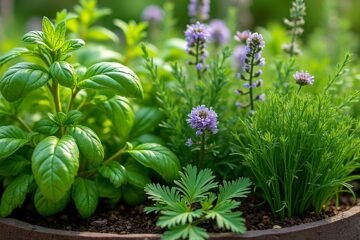Ready to transform your small space into a vegetable paradise? Start by picking climbing veggies like pole beans and cherry tomatoes—they’re perfect for vertical growth! Build a sturdy, eye-catching structure using recycled materials, and don’t forget your containers must drain well. Keep an eye on your plants’ hydration, and use some homemade remedies for pesky bugs. Excited for lush greens and juicy harvests? Stick around, and you’ll uncover even more gardening secrets!
Selecting the Right Vegetables for Vertical Growth
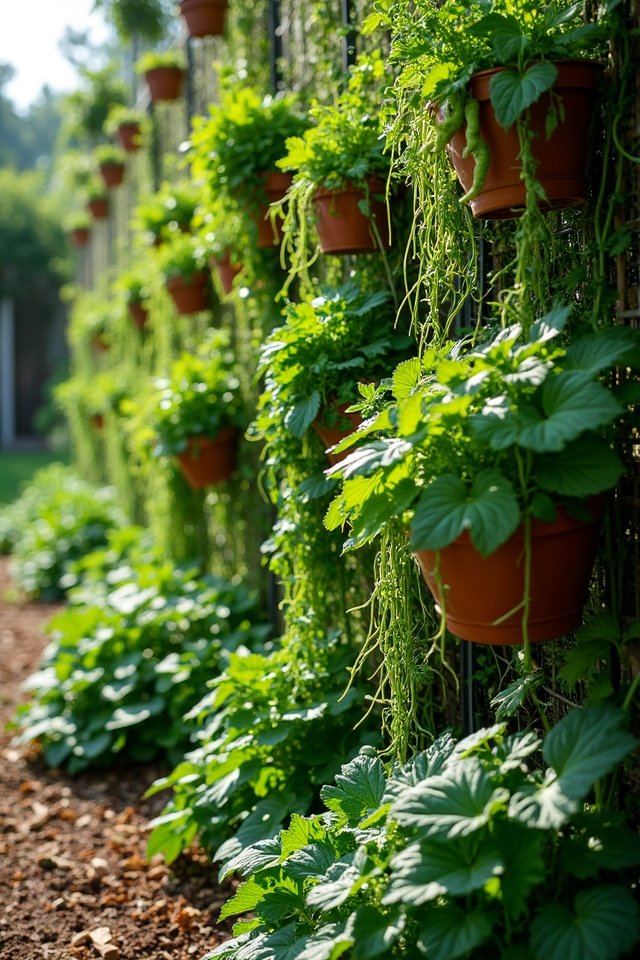
When you’re ready to plunge into vertical gardening, choosing the right vegetables can feel like trying to find the perfect pair of shoes—it’s all about fit! Climbing vegetables like pole beans, peas, and cucumbers are your go-to options for maximizing space efficiency and creating a lush, green oasis. Imagine those sturdy vines soaring upwards, creating a visual feast! Don’t forget about cherry tomatoes; they’re not just delicious, but also perfect for vertical growth, draping gracefully like nature’s garland. You’ll love how they transform limited space into vibrant gardens, bringing a splash of color to your life. So, roll up your sleeves and get planting! Who knew vertical gardening could be so thrilling? Adventure awaits with every seed you sow!
Designing Your Vertical Garden Structure
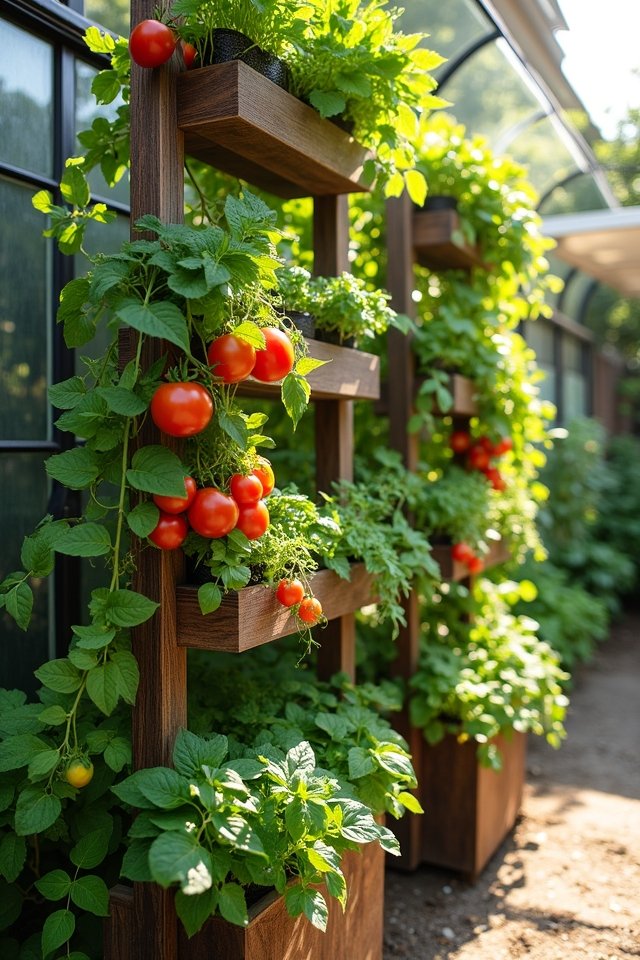
As you plunge into the world of vertical gardening, designing your garden structure might just be the most exciting part of your adventure! Picture a stunning tower of greens climbing toward the sky, right in your backyard! When choosing your vertical garden materials, consider durable options like sturdy wood or galvanized metal; they’ll guarantee structural stability, keeping your leafy friends safe and sound. You might even experiment with recycled pallets—eco-friendly and fabulously unique! Don’t forget to add built-in trellises or netting to help support climbing veggies! Just imagine those vibrant tomatoes twisting playfully upward to soak in the sun! With a bit of creativity and some robust materials, your vertical garden can be both beautiful and bountiful—an innovative feast for the eyes and your taste buds!
Preparing Containers for Vertical Gardening
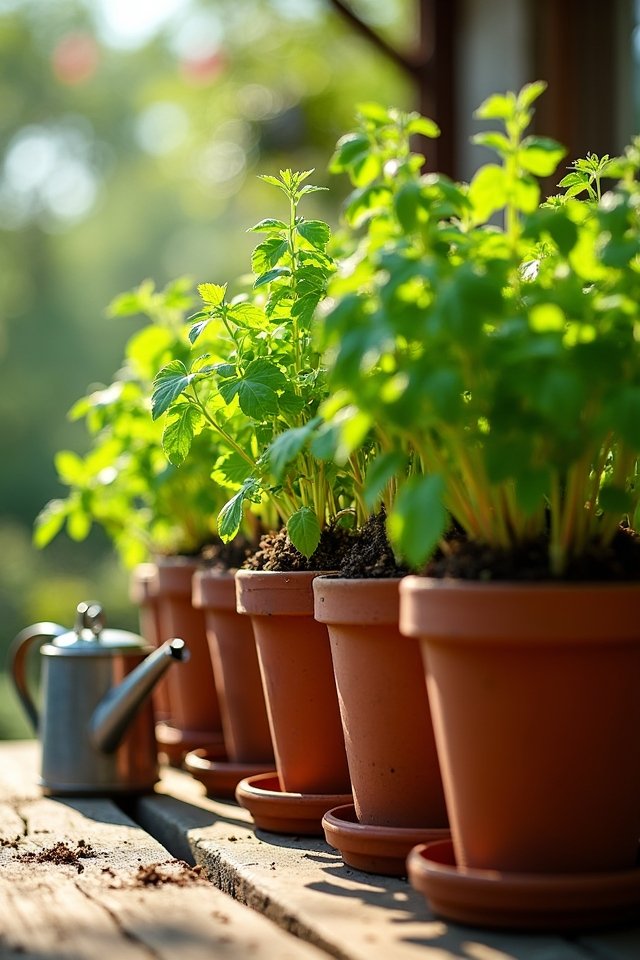
Getting your containers ready for vertical gardening is a delightful and essential step in creating your green oasis! First, choose your container materials wisely—think vibrant terra cotta, sleek metal, or eco-friendly recycled plastic! Each adds unique flair to your garden while impacting functionality.
Now, let’s tackle drainage considerations! Nothing ruins your green dreams faster than soggy roots. Make sure your chosen containers have drainage holes—imagine your veggies drowning, yikes! You can also elevate the pots using small rocks or clay shards at the bottom.
Experiment with various sizes, shapes, and colors to release your creativity! Who knew preparing containers could be this fun? With a little thought and heart, you’re on your way to a vertical garden that’ll make your neighbors green with envy!
Essential Care Tips for Vertical Vegetables
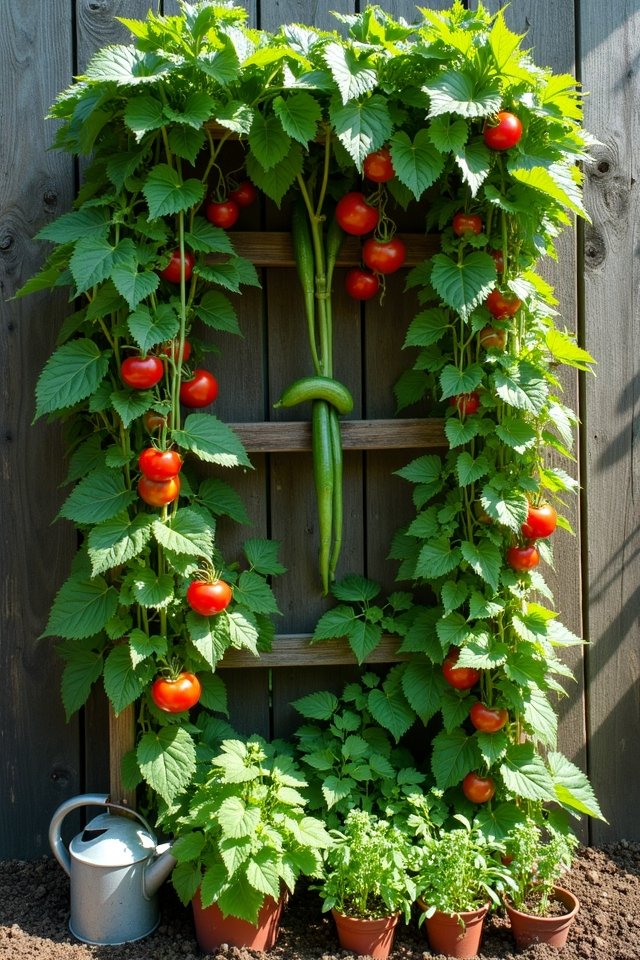
To keep your vertical vegetables thriving, it’s essential to give them the love and attention they deserve! Watering is critical, so remember, these plants have different water requirements than traditional gardens. Check your containers daily—think of them as thirsty little friends, begging for hydration. When pests make an appearance, arm yourself with homemade sprays from soapy water or neem oil! Can you imagine a ladybug swooping in to save the day?
Always remove yellowing leaves to keep your plants robust and strong, just like you would toss out stale chips. By monitoring growth and using innovative solutions, you’ll enjoy bountiful harvests! You’ll feel like a gardening superhero—cape optional! So, plunge into it, and watch your vertical garden flourish with joy!
Maximizing Space With Companion Planting
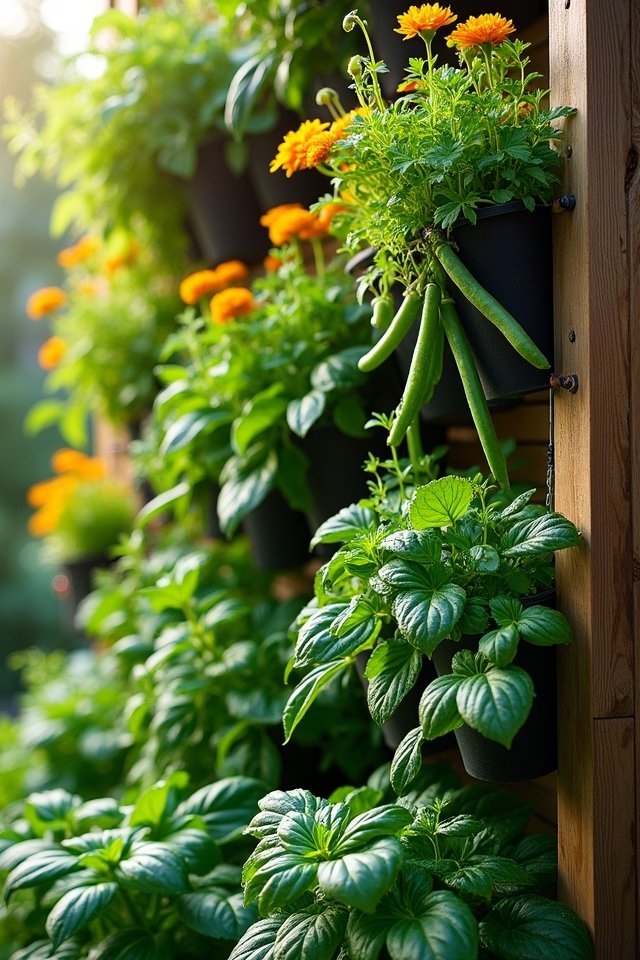
With strong, healthy vertical veggies already thriving in your garden, what’s next? It’s time to explore companion planting! This innovative technique can spark incredible growth while saving space. Here are three tips to maximize plant compatibility and productivity:
- Supportive Pairings: Plant tomatoes with basil. They not only love each other but enhance flavor too!
- Deterrent Friends: Marigolds are fantastic companions for veggies. They ward off pests, giving your greens a fighting chance.
- Shared Spaces: Try growing cucumbers with beans; the beans’ll climb, while the cucumbers provide shade.
Harvesting Techniques for Optimizing Yield
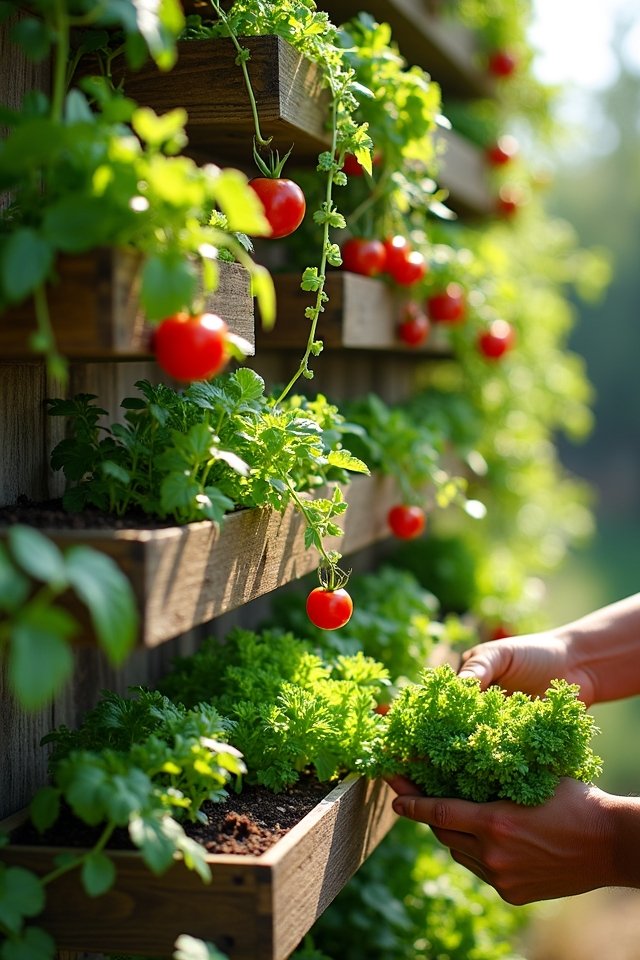
Ready to reap the rewards of your hard work? Harvesting isn’t just snipping veggies; it’s an art! Immerse yourself in seasonal harvesting to guarantee you pick your crops at their peak—think of it as catching a perfect wave! Use smart pruning techniques to encourage your plants to grow stronger and produce more. For example, snip away spent leaves and overripe fruits to stimulate new growth. Your peppers and tomatoes will thank you with a bounty! And don’t forget—embracing a staggered harvest approach means you’re savoring fresh veggies bit by bit, rather than a chaotic one-time haul. Visualize plucking plump cherry tomatoes in the morning sun—it’s bliss! So grab those shears, and let’s optimize those yields with flair!
Frequently Asked Questions
Can Vertical Gardening Be Done Indoors as Well?
Absolutely, you can bring vertical gardening indoors! Think of your living room as a tiny jungle, alive with vibrant greens. With the right indoor lighting, you can make the most out of every nook and cranny. You’ll optimize space beautifully, like turning a closet into a mini herb haven. Imagine fresh basil right above your kitchen counter! Why settle for empty walls when they can bloom with life? Get growing, and let nature inspire you!
What Soil Type Is Best for Vertical Gardening?
When you’re diving into vertical gardening, picking the right soil is key! Think of soil composition as the foundation for your leafy skyscrapers. Aim for a mix of light, well-draining potting soil and compost. This combo encourages healthy roots while ensuring proper drainage—like a cozy bed for your plants! So, when you’re stacking those fresh veggies vertically, remember: happy roots mean happy harvests! Who doesn’t want a garden that reaches for the sky?
How Much Sunlight Does a Vertical Garden Need?
Your vertical garden craves sunlight like you crave your morning coffee! Aim for at least six hours of ideal exposure daily. Consider your plant choices—tomatoes love a sunny spot, while leafy greens can tolerate a bit of shade. Rotate your plants for balanced light, like a sunbather shifting positions! If your plants start stretching toward the light, they’re definitely begging for more. So, make that sunlight work its magic!
Can I Use Recycled Materials for Vertical Structures?
Absolutely, you can use recycled materials for your vertical structures! Imagine this: recycled pallets stacked like veggie skyscrapers, or hanging bottles swaying gently in the breeze, cradling your plants like cozy beds. Not only are they eco-friendly, but they also spark creativity! Just think about it, turning trash into treasure! Your garden will be a unique masterpiece, bursting with life! So grab those materials and let your imagination run wild!
What Pests Should I Be Aware of in Vertical Gardening?
When you’re exploring vertical gardening, keep an eye out for pesky intruders! Pest identification is key—watch for aphids, spider mites, and whiteflies. Like tiny ninjas, they can sneak in and wreak havoc! But don’t panic; try some organic solutions! Neem oil works wonders, and introducing ladybugs to your garden can be a game-changer. These cute little critters are natural pest controllers! Isn’t that a delightful way to keep your greens healthy?


